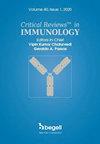N6-甲基腺苷(m6A)阅读器 LRPPRC 介导的 CXCL11 可诱导细胞发炎,从而促使乳腺癌细胞恶变
IF 0.9
4区 医学
Q4 IMMUNOLOGY
引用次数: 0
摘要
背景:乳腺癌(BC)是女性发病率最高的恶性肿瘤之一。本文拟研究含 N6-甲基腺苷(m6A)的富含亮氨酸五肽重复序列(LRPPRC)在 BC 炎症和进展中的功能及调控机制:方法:通过 qRT-PCR 检测 LRPPRC 和 C-X-C motif 趋化因子配体 11(CXCL11)的水平。方法:通过 qRT-PCR 检测 LRPPRC 和 C-X-C motif 趋化因子配体 11(CXCL11)的水平,通过 RIP、MeRIP 和 mRNA 稳定性实验研究 LRPPRC 和 CXCL11 之间的调控机制。此外,还通过 CCK8、伤口愈合和 Transwell 试验探讨了 LRPPRC 和 CXCL11 在 BC 细胞中的生物功能。利用酶联免疫吸附法评估了促炎细胞因子(TNF-α、IL-6、IL-1β)的水平:结果:LRPPRC在BC样本中的水平远高于健康样本,LRPPRC过表达预示着预后不良。LRPPRC 低表达会降低 BC 细胞的活力、迁移和侵袭,而过表达则会促进恶性肿瘤的发生。LRPPRC通过CXCL11 m6A修饰发挥刺激作用。CXCL11 上调抑制了 LRPPRC 沉默对 BC 细胞恶性肿瘤的抗肿瘤作用。CXCL11上调可促进BC细胞分泌炎症因子:本研究表明,LRPPRC通过上调CXCL11的m6A修饰,加重了BC细胞的炎症和恶性程度。这些发现有望成为治疗 BC 患者的靶点。本文章由计算机程序翻译,如有差异,请以英文原文为准。
N6-methyladenosine (m6A) reader LRPPRC-mediated CXCL11 induces cell inflammation to drive breast cancer cell malignancy
Background: Breast cancer (BC) is among the most prevalent malignant cancers in women. This paper proposed to investigate the function as well as the regulatory mechanism of N6-methyladenosine (m6A) reader leucine rich pentatricopeptide repeat containing (LRPPRC) in BC inflammation and progression.
Methods: The levels of LRPPRC and C-X-C motif chemokine ligand 11 (CXCL11) were detected via qRT-PCR. The regulatory mechanisms between LRPPRC and CXCL11 were investigated by RIP, MeRIP, and mRNA stability experiments. Moreover, the bio-functions of LRPPRC and CXCL11 in BC cells were explored through the CCK8, wound healing, Transwell assays. ELISA was utilized to evaluate pro-inflammatory cytokines (TNF-α, IL-6, IL-1β) levels.
Results: LRPPRC had a considerably higher level in BC samples than in healthy samples, and LRPPRC overexpression predicted poor prognosis. LRPPRC lowexpression diminished BC cell viability, migration, and invasion, whereas overexpression facilitated malignancy. LRPPRC exerted its stimulative effect through CXCL11 m6A modification. CXCL11 upregulating suppressed the LRPPRC silencing’s antitumor effect on BC cells malignancy. CXCL11 upregulation enhances inflammatory factors secretion by BC cells.
Conclusion: This study demonstrated that LRPPRC aggravated BC inflammation and malignancy by upregulating m6A modification of CXCL11. These findings offered a potential to be a target for BC patients’ therapy.
求助全文
通过发布文献求助,成功后即可免费获取论文全文。
去求助
来源期刊
CiteScore
2.60
自引率
0.00%
发文量
14
审稿时长
>12 weeks
期刊介绍:
Immunology covers a broad spectrum of investigations at the genes, molecular, cellular, organ and system levels to reveal defense mechanisms against pathogens as well as protection against tumors and autoimmune diseases. The great advances in immunology in recent years make this field one of the most dynamic and rapidly growing in medical sciences. Critical ReviewsTM in Immunology (CRI) seeks to present a balanced overview of contemporary adaptive and innate immune responses related to autoimmunity, tumor, microbe, transplantation, neuroimmunology, immune regulation and immunotherapy from basic to translational aspects in health and disease. The articles that appear in CRI are mostly obtained by invitations to active investigators. But the journal will also consider proposals from the scientific community. Interested investigators should send their inquiries to the editor before submitting a manuscript.

 求助内容:
求助内容: 应助结果提醒方式:
应助结果提醒方式:


